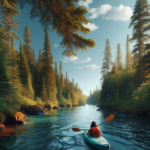Kayaking in Cape Peninsula, South Africa
Introduction to Kayaking
Kayaking is an exhilarating outdoor activity that has gained immense popularity worldwide. It offers a unique blend of adventure, exercise, and a chance to connect with nature. Whether you’re paddling through serene lakes, navigating swift rivers, or exploring coastal waters, kayaking provides a thrilling experience that appeals to both beginners and seasoned adventurers. The sport’s versatility and accessibility make it a favorite among outdoor enthusiasts.
In this article, we will spotlight the unique features of kayaking in Cape Peninsula, South Africa. This region is renowned for its stunning landscapes, diverse marine life, and favorable kayaking conditions. We’ll explore why Cape Peninsula stands out as a fantastic destination for kayaking enthusiasts and provide detailed information to help you plan your kayaking adventure.
Kayaking in Cape Peninsula, South Africa, offers a unique experience that combines breathtaking scenery, rich biodiversity, and a sense of adventure. The region’s diverse marine life, including seals, dolphins, and even penguins, adds an extra layer of excitement to your kayaking journey. Whether you’re a novice or an experienced kayaker, Cape Peninsula has something to offer for everyone.
Overview of Kayaking in Cape Peninsula, South Africa
Cape Peninsula, located at the southwestern tip of South Africa, is a kayaker’s paradise. The region boasts a diverse geography that includes rugged coastlines, pristine beaches, and sheltered bays. The climate is Mediterranean, characterized by warm, dry summers and mild, wet winters, making it an ideal year-round destination for kayaking. The area’s rich history and cultural ties to water sports further enhance its appeal.
Visitors can access Cape Peninsula via Cape Town, which is well-connected by air and road. From Cape Town, it’s a short drive to various kayaking spots along the peninsula. The best times to visit are during the spring and summer months (September to March) when the weather is warm and the seas are relatively calm. However, winter kayaking can also be rewarding, especially for those seeking a quieter experience.
The region’s historical and cultural ties to water sports are evident in the numerous kayaking clubs and events held throughout the year. Local communities have embraced kayaking as a way to connect with their natural surroundings and promote eco-tourism. This cultural appreciation for water sports adds a unique dimension to your kayaking adventure in Cape Peninsula.
Overall, Cape Peninsula offers a perfect blend of natural beauty, favorable weather conditions, and cultural richness, making it a top choice for kayaking enthusiasts. Whether you’re looking to explore hidden coves, paddle alongside marine wildlife, or simply enjoy the stunning coastal views, Cape Peninsula has it all.
Kayaking Conditions in Cape Peninsula, South Africa
The waters around Cape Peninsula are primarily coastal, offering a mix of calm bays and more challenging open sea conditions. The region’s Mediterranean climate means that weather conditions can vary, but generally, the seas are calmest during the summer months. Spring and autumn also offer good kayaking conditions, with mild temperatures and moderate sea states.
Water currents and tides are important factors to consider when kayaking in Cape Peninsula. The Atlantic Ocean’s influence means that tides can be significant, especially around the full and new moons. It’s essential to check tide charts and plan your kayaking trips accordingly to avoid strong currents and ensure a safe experience. Local guides and rental facilities often provide this information to help you plan your adventure.
Wind conditions can also impact your kayaking experience. The Cape Peninsula is known for its strong south-easterly winds, particularly during the summer months. These winds can create choppy conditions, especially in more exposed areas. However, sheltered bays and coves offer protection from the wind, making them ideal spots for kayaking even on windy days.
Overall, the kayaking conditions in Cape Peninsula are diverse, offering something for everyone. Whether you prefer calm, sheltered waters or more challenging open sea conditions, you’ll find suitable spots to explore. Just be sure to check weather forecasts, tide charts, and wind conditions before heading out to ensure a safe and enjoyable experience.
Top Spots for Kayaking in Cape Peninsula, South Africa
One of the top spots for kayaking in Cape Peninsula is Simon’s Town. This charming coastal town offers calm, sheltered waters perfect for beginners and families. The area is also home to a colony of African penguins at Boulders Beach, making it a unique and exciting kayaking destination. The best time to kayak here is during the early morning when the waters are calm, and the penguins are most active.
Another popular spot is Hout Bay, known for its stunning scenery and diverse marine life. Kayakers can explore the bay’s calm waters, paddle around the iconic Sentinel peak, and even encounter seals and dolphins. The best time to visit Hout Bay is during the summer months when the weather is warm, and the seas are relatively calm. Early mornings and late afternoons offer the best conditions for kayaking.
For those seeking a more challenging experience, Cape Point offers rugged coastlines and open sea conditions. This area is known for its dramatic cliffs, hidden coves, and abundant marine life. Kayaking around Cape Point requires more experience due to the strong currents and winds, but the breathtaking scenery and sense of adventure make it well worth the effort. The best time to kayak here is during the spring and autumn months when the weather is mild, and the seas are more manageable.
Lastly, False Bay is another excellent kayaking destination in Cape Peninsula. This large bay offers a variety of kayaking experiences, from calm, sheltered waters to more exposed areas with stronger currents. The bay is also home to diverse marine life, including seals, dolphins, and even whales during the migration season. The best time to visit False Bay is during the summer months when the weather is warm, and the seas are calm.
Safety and Regulations
Safety is paramount when kayaking in Cape Peninsula, South Africa. Local regulations require all kayakers to wear life jackets and carry essential safety gear, including a whistle, a waterproof map, and a first aid kit. It’s also recommended to paddle in groups and inform someone of your planned route and expected return time. These precautions ensure that you are prepared for any unexpected situations that may arise.
In addition to wearing life jackets, it’s essential to check weather forecasts and tide charts before heading out. Sudden changes in weather and sea conditions can pose significant risks, so being well-informed is crucial. Local guides and rental facilities often provide up-to-date information on weather and tides, helping you plan your kayaking trip safely.
Emergency situations can occur, so it’s important to know how to handle them. If you capsize, stay with your kayak and signal for help using your whistle or other signaling devices. In case of strong currents or winds, paddle parallel to the shore until you reach calmer waters. Familiarizing yourself with basic rescue techniques and practicing them regularly can make a significant difference in an emergency.
Overall, adhering to local safety regulations and guidelines is essential for a safe and enjoyable kayaking experience in Cape Peninsula. By taking the necessary precautions and being well-prepared, you can fully enjoy the beauty and adventure that this stunning region has to offer.
Amenities and Accommodations
Cape Peninsula offers a range of amenities to enhance your kayaking experience. Numerous rental facilities provide high-quality kayaks, paddles, and safety gear. Many of these facilities also offer guided tours, which can be a great way to explore the area with the help of experienced local guides. These tours often include safety briefings, equipment rentals, and insights into the region’s natural and cultural history.
Accommodation options in Cape Peninsula are diverse, catering to various preferences and budgets. From luxury hotels and lodges to cozy guesthouses and camping sites, you’ll find something that suits your needs. Many accommodations are located near popular kayaking spots, providing easy access to the water and stunning coastal views. Booking in advance is recommended, especially during peak tourist seasons.
In addition to kayaking, Cape Peninsula offers a variety of recreational activities for visitors to enjoy. Hiking trails, wildlife viewing, and scenic drives are just a few of the options available. The region’s rich biodiversity and stunning landscapes make it a paradise for nature lovers and outdoor enthusiasts. Whether you’re looking to relax on the beach, explore the rugged coastline, or immerse yourself in local culture, there’s something for everyone.
Overall, Cape Peninsula provides a well-rounded experience for kayaking enthusiasts. With excellent amenities, comfortable accommodations, and a wide range of recreational activities, you can enjoy a memorable and fulfilling adventure in this beautiful region.
Environmental Considerations
Preserving the natural habitats and wildlife of Cape Peninsula is of utmost importance. Kayakers are encouraged to practice eco-friendly kayaking by minimizing their impact on the environment. This includes avoiding disturbing marine life, not littering, and using biodegradable products. Respecting the natural surroundings ensures that future generations can continue to enjoy the beauty and biodiversity of this unique region.
Local conservation efforts play a significant role in protecting the environment of Cape Peninsula. Various organizations and community groups are dedicated to preserving marine habitats, conducting research, and promoting sustainable tourism practices. Visitors can support these efforts by participating in local conservation projects, donating to environmental organizations, and spreading awareness about the importance of conservation.
Eco-friendly kayaking practices also involve being mindful of your actions on the water. Avoid approaching wildlife too closely, as this can cause stress and disrupt their natural behaviors. Stick to designated kayaking routes and avoid sensitive areas such as nesting sites and coral reefs. By following these guidelines, you can enjoy a responsible and respectful kayaking experience.
Overall, being environmentally conscious while kayaking in Cape Peninsula is essential for preserving its natural beauty and biodiversity. By adopting eco-friendly practices and supporting local conservation efforts, you can contribute to the long-term sustainability of this remarkable region.
Highlights
When comparing kayaking in Cape Peninsula, South Africa, with other popular kayaking destinations, several unique features stand out. The region’s diverse marine life, including seals, dolphins, and penguins, offers a one-of-a-kind wildlife experience. The stunning coastal landscapes, with their rugged cliffs and hidden coves, provide a picturesque backdrop for your kayaking adventure.
Geographically, Cape Peninsula’s location at the meeting point of the Atlantic and Indian Oceans creates a dynamic and diverse marine environment. This unique feature contributes to the region’s rich biodiversity and varied kayaking conditions. The combination of calm bays and more challenging open sea areas caters to kayakers of all skill levels, making it an ideal destination for both beginners and experienced paddlers.
Historically, Cape Peninsula has a rich cultural heritage tied to water sports and maritime activities. The local communities’ appreciation for kayaking and eco-tourism adds a cultural dimension to your adventure. Participating in local events and engaging with the community can enhance your understanding of the region’s history and traditions.
Overall, the unique biodiversity, geographical features, and historical significance of Cape Peninsula make it a standout destination for kayaking enthusiasts. Whether you’re drawn to the region’s wildlife, stunning landscapes, or cultural richness, Cape Peninsula offers an unforgettable kayaking experience.
FAQ Section
- What is the best season to go kayaking in Cape Peninsula? The best season for kayaking in Cape Peninsula is during the spring and summer months (September to March) when the weather is warm and the seas are relatively calm.
- Are there beginner-friendly spots for kayaking in Cape Peninsula? Yes, Simon’s Town and Hout Bay are beginner-friendly spots with calm, sheltered waters ideal for novice kayakers.
- What should I bring for a kayaking trip in Cape Peninsula? Essential items include a life jacket, paddle, waterproof map, first aid kit, sunscreen, hat, water bottle, and snacks.
- Are kayak rentals available in Cape Peninsula? Yes, there are numerous rental facilities offering high-quality kayaks, paddles, and safety gear. Guided tours are also available.
- How can I participate in local conservation efforts? You can support local conservation efforts by participating in community projects, donating to environmental organizations, and practicing eco-friendly kayaking.
- Are guided kayaking tours available? Yes, guided tours are available and often include safety briefings, equipment rentals, and insights into the region’s natural and cultural history.
- What safety measures should I take while kayaking in Cape Peninsula? Always wear a life jacket, check weather forecasts and tide charts, paddle in groups, and inform someone of your planned route and expected return time.
Final Thoughts
Kayaking in Cape Peninsula, South Africa, is a premier destination for kayaking enthusiasts. The region’s stunning landscapes, diverse marine life, and favorable kayaking conditions make it an unforgettable experience. Whether you’re a novice or an experienced kayaker, Cape Peninsula offers something for everyone.
Respecting local guidelines and conservation efforts is essential for preserving the natural beauty and biodiversity of Cape Peninsula. By practicing eco-friendly kayaking and supporting local conservation projects, you can contribute to the long-term sustainability of this remarkable region.
In conclusion, Cape Peninsula is a must-visit destination for anyone passionate about kayaking. The combination of breathtaking scenery, rich biodiversity, and a sense of adventure makes it a truly unique and rewarding experience. So pack your gear, plan your trip, and get ready to explore the beauty and thrill of kayaking in Cape Peninsula, South Africa.









